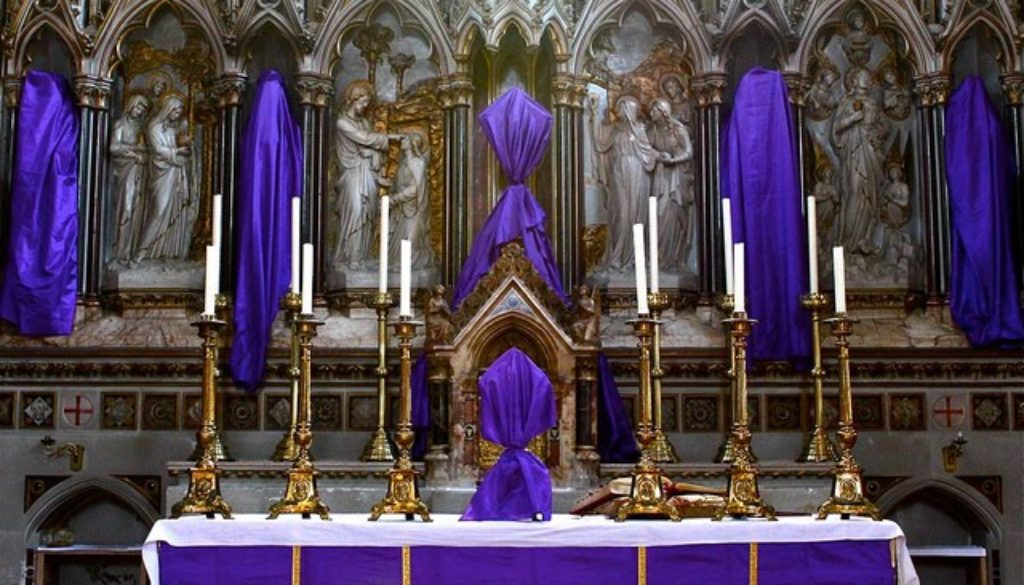Covering the Cross
We began Ash Wednesday with a fast to humble ourselves before God. In the weakness of that hunger and in the outward presence of our ashes we anticipated the work of God to be present among us. During our moments of famine and meditation, I pray that He has revealed to us areas of our lives that we have failed to surrender to Him. Micah 6:8 reminds us that God is not concerned with mere external sacrifice; our lenten fasts (coffee, chocolate, social media, vegan diets, etc.) are a tool–at the most rudimentary level–to help us enter into the sufferings of Christ as we anticipate living in that resurrection glory with Him. So why veil the symbol of the victory of our glorious Lord and Savior? The veiled cross reminds us to be penitent and veils our view of the Triune God’s work. The veil also reminds us to focus on the process leading up to Christ’s crucifixion so that Easter’s beauty becomes a more glorious realization of our future hope.
Tradition
The English tradition of covering sacred objects with a veil during Lent can be traced back to the 9th century.[1] Along with the removal of “Allelujah” from the liturgy, the church removed other signs of joy and happiness from the church, which included covering the altar and other sacred objects. Although utilizing purple veils beginning on the 5th Sunday of Lent (Passiontide) is a more recent tradition, they both have as their base the same communicative force– to strengthen the penitential nature of Lenten devotion.
Increasing Lenten Devotion
Week five of Lent often contains the Gospel reading from John 8:46-59, recounting the story of Jesus elucidating true discipleship to a group of Jewish hearers. After Jesus proclaims that His word is superior to that of Abraham and the prophets, those standing by picked up rocks to stone Him. Verse 59 says, “Jesus hid himself and went out of the temple.” The veil over the cross invites us who follow Christ to open ourselves to those areas in which we fail to trust our God. Christ left, but those men still stood there with rocks in hand, unaware that their hearts were hardened beyond the hardness of the rocks they carried. When we experience Christ’s abandonment during our rebellion, what are we left carrying in our hands? A shrouded cross reminds us to drop what is in our hands–the rebellion we hold onto so tightly–and turn a tear-filled eye to the God who wants to renew our hearts.
Veiling Christ’s Work and our Victory
The cross symbolizes God’s act of salvation and Christ’s ultimate suffering, so why veil this symbol? The cross is not only a symbol of salvation and suffering, but one of victory. When we look at the veil, we know what is behind it, but we can only see it in part. To borrow the Pauline metaphor, we only see through a mirror dimly (1 Cor 13:12). We are reminded that by God’s grace, the small victories we experience, the traces of God’s love we feel, and the small portions of His peace in which we share are all a merely veiled expression of the glory we will experience in His resurrection life.
Focus on Process
Because the cross is our mysterious entrance into victory of God, we often fail to focus on the process leading up to the crucifixion. The veil calls us to enter into the experience of Christ’s life and sufferings. Christ was not merely born and then hung on a cross; the crucifixion was three decades in the making. Multitudes hailed him as king, but traded him for a criminal. Mouths acclaimed Him as a great teacher only to falsely accused Him before the Sanhedrin. We veil the cross to enter into the narrative leading up to the betrayal of our Lord. As He divested Himself of all He was, so we come to God, divesting ourselves of the cares, sins, anxieties, fears, injustices, and the offenses that we carry. Dying daily becomes an imperative with a paradigm patterned on the life of Christ.
Conclusion
The veil shrouding the cross supports our penitential season by exhorting us to internalize our fasts and to enter into the sufferings of Christ. The veil reminds us that the glory of God we experience now is only a veiled look at the true glory of our future victory. A veiled cross focuses our gaze upon the process leading up to Christ’s crucifixion, death, resurrection, and ascension. When the cross is finally unveiled, the joy of Christ’s victory inscribes an indelible mark upon our heart and mind.
Almighty God, you alone can bring into order the unruly
wills and affections of sinners: Grant your people grace to
love what you command and desire what you promise; that,
among the swift and varied changes of the world, our hearts
may surely there be fixed where true joys are to be found;
through Jesus Christ our Lord, who lives and reigns with
you and the Holy Spirit, one God, now and for ever. Amen.[2]
[1] Christopher Yoder, “Veiling Crosses in Lent,” http://livingchurch.org/covenant/?p=5064 [accessed March 5, 2015].
[2] A collect for the 5th Sunday of Lent, Book of Common Prayer, 219.

